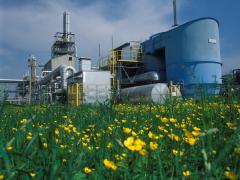N2O and NO emission from agricultural fields and soils under natural vegetation
In this paper we present the latest analysis of N2O and NO emission measurement data for agricultural soils which has been used in the update of the IPCC Guidelines for National Emission Inventories. For N2O and NO emissions from soils under natural ecosystems this study is the first comprehensive statistical analysis of published measurement data.
The number of published measurements of N2O and NO emissions from soils is increasing steadily, providing additional information about driving factors of these emissions and allowing an improvement of statistical N-emission models.
We extended the N2O and NO emission data set presented by Bouwman et al. (2002a) with data for N2O and NO emissions from soils under natural vegetation and added more measurements for agricultural fields. The data set contains results from field studies that were published in the peer-reviewed literature, including various parameters related to climate, soil, management and measurement technique. The measurement data as well as the literature references can be obtained from this site.
The statistical models presented in this study are useful to estimate seasonal or annual N2O and NO emissions based on site-specific environmental and management parameters, and as they include estimates of uncertainty, they can serve as a benchmark to process-based models applied at larger spatial scales. The results of this paper have been used in the revision of the IPCC Guidelines for national Greenhouse Gas Inventories.
Agricultural soils
The data set contains 1125 measurements for N2O and 199 for NO from agricultural fields, which is a considerable improvement compared to the 846 (N2O) and 99 (NO) measurements used by Bouwman et al. (2002a;b). The factors that significantly influence agricultural N2O emissions were N application rate, crop type, fertilizer type, soil organic C content, soil pH and texture, and those for NO emissions include N application rate, soil N content and climate.
Compared to the earlier analysis of Bouwman et al. (2002a;b) the 20 % increase in the number of N2O measurements for agriculture did not yield more insight or reduced uncertainty, because the representation of environmental and management conditions in agro-ecosystems did not improve, while for NO emissions the additional measurements in agricultural systems did yield a considerable improvement.
For NO emissions from agricultural fields the analysis is based on a much larger number of measurements (200 %) compared to Bouwman et al. (2002b), now covering a higher diversity of environmental conditions. The uncertainty of NO emission estimates was considerably reduced compared to the previous analysis. NO emissions are significantly influenced by N application rate, soil N content and climate.
Statistical models of these factors were used to calculate global annual emissions from fertilized cropland (3.3 Tg N2O-N and 1.4 Tg NO-N) and grassland (0.8 Tg N2O-N and 0.4 Tg NO-N) (Figure 1 and 2).
Soils under natural vegetation
For soils under natural vegetation 207 measurements for N2O from 72 references and 210 measurements for NO from 52 references were used. N2O emissions from soils under natural vegetation are significantly influenced by vegetation type, soil organic C content, soil pH, bulk density and drainage, while vegetation type and soil C content are major factors for NO emissions.
Figures 3 and 4 provide the results for N2O and NO, respectively. Given the incomplete coverage of global vegetation zones and the high uncertainty of the developed statistical models, global annual emissions cannot be calculated with this approach. Far more measurement data, and particularly a better representation of the vegetation types tropical dry forest, savanna, tundra and temperate ecosystems that are not affected by N deposition, preferably covering prolonged periods, are needed to understand the complexity of interactions.
Authors
Specifications
- Publication title
- N2O and NO emission from agricultural fields and soils under natural vegetation
- Publication subtitle
- Summarizing available measurement data and modeling of global annual emissions
- Publication date
- 11 April 2006
- Publication type
- Article
- Page count
- 22
- Publication language
- English
- Magazine
- Nutrient Cycling in Agroecosystems
- Issue
- March 2006, Volume 74, Issue 3, pp 207-228
- Product number
- 91709




